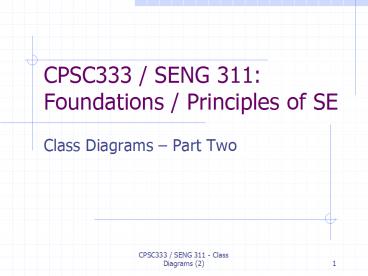CPSC333 SENG 311: Foundations Principles of SE - PowerPoint PPT Presentation
1 / 25
Title:
CPSC333 SENG 311: Foundations Principles of SE
Description:
they are not killed when the Flames disappear. Polygon. color. texture. Point. Graphics ... Draw a class diagram to model the following information: ... – PowerPoint PPT presentation
Number of Views:61
Avg rating:3.0/5.0
Title: CPSC333 SENG 311: Foundations Principles of SE
1
CPSC333 / SENG 311 Foundations / Principles of SE
- Class Diagrams Part Two
2
Agenda
- Class diagrams Tips and Tricks
- Classes and Objects
- Aggregation
- Example
3
When to use class diagrams
- Class diagrams are the backbone of OO development
approaches - Dont use all the notations
- start with simple features
- use advanced features only when necessary
- Take the perspective into account
- not too many details in analysis
- specification models during design
- use implementation models only to illustrate
particular implementation techniques
4
When to use class diagrams (cont.)
- Concentrate on key areas
- better few up-to-date diagrams than many obsolete
models - Focus on conceptual and specification perspectives
5
How to define classes ? (Rules of Thumb)
- Look for nouns in the Use Cases
- Define a class for every noun ( add others)
- Document the set of rules that determine the set
of objects belonging to the class - Add associations to model the relations
- Think about the subset relationship to build
generalizations ... - Use object characteristics for attributes
- Use objects activities for operations
6
Creating a class diagram
- Start simple
- major classes obvious associations
- Then add
- Attributes
- Multiplicity
- Operations
- Responsibilities
7
Avoid Heavy classes
- Controller does everything
- Other classes Data encapsulation only
A
D
HeavyControler
doIt( )
?DO NOT DO IT!!!! ?
B
C
8
Agenda
- Class diagrams Tips and Tricks
- Classes and Objects
- Aggregation
- Example
9
Classes and Objects
- As mentioned, a class defines the structure of a
group of objects - It defines
- name
- attributes
- operations
10
Classes and Objects
- Objects show
- Object name (underlined)
- Class name (optional)
- Attribute value (optional)
11
Example of Classes and Objects
Order
Salesperson
Line
Class diagram
CustInfo
line1 Line
order121Order
curtisClyde
line2
ace furniture
Named instance
line3
line4
Object diagram
Order
line1
harmon assoc
anonymous instance
line2
orphan instance
12
Agenda
- Class diagrams Tips and Tricks
- Classes and Objects
- Aggregation
- Example
13
Aggregation
- Special form of association
- Components are parts of aggregated object
- Car has an engine and wheels as its part
- Aggregation is transitive
- Anti-symmetric Object may not be directly or
indirectly part of itself - Typical example
- parts explosion
- organizational structure of a company
14
Notation for aggregation
or
- conceptually distinguishes the whole from the
part - No info concerning navigability or life-time
15
Example Aggregation
Company
Unit
Department
Group
works for
Employee
16
Aggregation and composition
- Composition
- Parts belong only to one whole
- Parts live and die with the whole
- cascading delete
- Note Also needed for 1..1 associations
- The players can be aggregated for the
FlamesBUTthey are not killed when the Flames
disappear
17
How to recognize aggregation?
- Question Association or aggregation?
- Description part of correct?
- Operation on whole affects parts, too?
18
Recursion
- Directed path of aggregation associations from a
class to itself - Variable aggregation finite number of levels,
number of parts variable (example company)
19
Example recursive aggregation
Object diagram
a Container
Class diagram
Item
c Container
b Icon
Icon
Container
d Icon
e Icon
20
Example Recursive aggregation
Class
21
Rules for using aggregation
- Distinction between association and aggregation
often rather matter of taste than difference in
semantics - Aggregation IS association
- Aggregate is inherently sum of its parts
- In Object Diagrams Chains of aggregate links
must not form cycles - Composition is appropriate when each part is
owned by one object, part does not have an
independent life from its owner
22
Agenda
- Class diagrams Tips and Tricks
- Classes and Objects
- Aggregation
- Example
23
Class Diagram - Example
- Draw a class diagram to model the following
information - A zoo consists of a set of cages.
- Every cage is the home of at least 2 animals.
- Cages are located besides each other.
- Every cage has at most one left neighbor and at
most one right neighbor. - Animals can be reptiles, insects, and mammals.
- Mammals are elephants, monkeys, and tigers.
- Monkeys eat bananas.
- Tigers prefer meat.
24
Class Diagram - Example
- Draw a class diagram to model the following
information - A University is made up of several departments.
It also has academic and non-academic staff who
work for the University. The academic staff,
called Professors, teach students. Students take
courses. Courses are held in rooms. Each room
can be assigned to as many courses as possible,
subject to scheduling constraints. A student can
also work for the university. Every staff
receives payroll once a month. Payroll is
subject to government taxes.
25
Were Available!
- Questions?
- if you have any questions about contents of this
lecture or other course-related issues, please
come by during our office hours, or send us
email - Dr. Joshua MTW, 12-1pm, ICT 548
- joshuar_at_cpsc.ucalgary.ca
- Dr. Walker WF, 1-2pm, ICT 546
- rwalker_at_cpsc.ucalgary.ca































